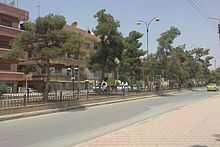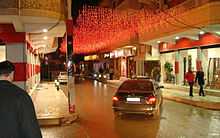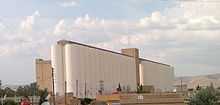Qamishli
| Qamishli قامشلي | |
|---|---|
 | |
 Qamishli | |
| Coordinates: 37°03′N 41°13′E / 37.050°N 41.217°E | |
| Country |
|
| Governorate | Al Hasakah |
| District | Qamishli |
| Population (2004)Census | |
| • Total | 184,231 |
| Time zone | EET (UTC+2) |
| • Summer (DST) | +3 (UTC) |
| Area code(s) | 52 |
Qamishli (Arabic: قامشلي Qāmišlī, Kurdish: Qamişlo, Syriac: ܩܡܫܠܐ Qamišlo or ܒܝܬ ܙܐܠܝ̈ܢ Beṯ Zālin) also Qamishly, Kamishli or Kamishly, is a city in north eastern Syria on the border with Turkey, adjoining the Turkish city of Nusaybin, and close to Iraq. It is part of the Al-Hasakah Governorate, and is the administrative capital of the Qamishli District within the governorate.
Qamishli is 680 kilometres (420 mi) northeast of Damascus.[1]
Etymology
The city was initially a small village inhabited by Assyrians/Syriacs called beṯ zālin (ܒܝܬ ܙܐܠܝ̈ܢ) meaning "house of reed". The current name is a turkified form of it, where "kamış" means "reed" in Turkish.
Demographics

With a population of 184,231 (2004 Census), Qamishli is among the 10 largest cities in Syria by population.
Qamishli is a somewhat mixed city with ethnic groups predominantly Kurdish, Christians and Arabs. The Christians of the city mainly consist of Assyrians/Syriacs and Armenians. The city was founded by Assyrian/Syriac refugees fleeing the Assyrian Genocide in modern Turkey.Today Kurds, Assyrians/Syriacs, Arabs and Armenians (about 8,500, of whom 2,000 are Armenian Catholics[2]) live side by side in the city.[3]
Al Qamishli was also home to a significant Jewish community. In the 1930s the Jewish population of Al Qamishli numbered 3,000. Since 1947, the situation of the Jews of Al Qamishli deteriorated. All Jews employed in government offices were sacked at once. Many Jewish women were imprisoned and beaten with the approval of the authorities. Massive immigration of Jews from Syria peaked due to violence, such as 1947 Aleppo pogrom. By 1963, the community had dwindled to 800 Jewish persons, and after the Six-Day War it went down further to 150 of whom only few remain today.
History

Qamishli is situated at the base of the Taurus Mountains, located near the area of ancient Hurrian city of Urkesh which was founded during the fourth millennium BC.
The modern city was founded in 1926 as a railway station on the Taurus railway.[4]
Qamishli is the largest town in Hassake province and it is regarded as the secret capital of the Kurds, the Assyrians/Syriacs also claim it to be their community capital. It is also the center of the Syrian Kurdish "problem."[5]
In March 2004, during a chaotic soccer match, a riot started when some people started praising Saddam, turning the match into political conflict against the Kurds. The riot expanded out of the stadium and weapons were used against people Kurdish background. In the aftermath, at least 30 Kurds were killed as the Syrian security services took over the city.[6] The event became known as "Qamishli massacre".
In June 2005, thousands of Kurds demonstrated in Qamishli to protest the assassination of Sheikh Khaznawi, a Kurdish cleric in Syria, resulting in the death of one policeman and injury to four Kurds.[7][8] In March 2008, according to Human Rights Watch,[9] Syrian security forces opened fire at Kurds celebrating spring festival of Newroz and purportedly gathering for reviving the 2004 riot in Qamishli. The shooting left three people dead.
The city is renowned for throwing a large Christmas parade every year in December, and celebrating Newroz festival by a large crowd every year in March. Despite the ethnic clashes, including during the 2012 Syrian civil war, both Kurds, Muslims, and Syriac Christian citizens lived side by side in peace, as well as the Armenian minority.
Climate
The Köppen Climate Classification subtype for this climate is "Csa" (Mediterranean Climate).[10]
| Climate data for Al-Qamishli | |||||||||||||
|---|---|---|---|---|---|---|---|---|---|---|---|---|---|
| Month | Jan | Feb | Mar | Apr | May | Jun | Jul | Aug | Sep | Oct | Nov | Dec | Year |
| Average high °C (°F) | 10.9 (51.6) |
12.6 (54.7) |
16.7 (62.1) |
22.1 (71.8) |
29.2 (84.6) |
36.1 (97) |
40.3 (104.5) |
39.8 (103.6) |
35.4 (95.7) |
28.3 (82.9) |
19.3 (66.7) |
12.7 (54.9) |
25.3 (77.5) |
| Average low °C (°F) | 2.7 (36.9) |
3.5 (38.3) |
6.3 (43.3) |
10.3 (50.5) |
14.9 (58.8) |
20.0 (68) |
23.5 (74.3) |
23.0 (73.4) |
19.5 (67.1) |
15.0 (59) |
8.8 (47.8) |
4.4 (39.9) |
12.7 (54.8) |
| Precipitation mm (inches) | 77.5 (3.051) |
71.9 (2.831) |
68.2 (2.685) |
59.0 (2.323) |
29.0 (1.142) |
2.2 (0.087) |
0.3 (0.012) |
0.1 (0.004) |
0.8 (0.031) |
18.0 (0.709) |
38.5 (1.516) |
66.9 (2.634) |
432.4 (17.025) |
| Avg. precipitation days | 11 | 11 | 11 | 10 | 6 | 1 | 0 | 0 | 0 | 4 | 7 | 10 | 71 |
| Source: World Meteorological Organization | |||||||||||||
Transportation

It has an international airport, Kamishly Airport, with IATA code KAC.
Chemins de Fer Syriens (the Syrian railroad company) operates a freight and passenger railway service to other parts of Syria
Media
The Kurdish-language newspaper Nu Dem has its headquarters in Qamishli.[1]
See also
- Assyrians/Syriacs in Syria
- Kurds in Syria
Notes
- ↑ 1.0 1.1 Zurutuza, Carlos. "Syria's first Kurdish-language newspaper." (Archive) Al Jazeera. 18 October 2013. Retrieved on 22 October 2013.
- ↑ (Armenian) Ծննդավայրս՝ Գամիշլի կամ Եղէգնուտ
- ↑ Al-Qamishli (Syria) - Britannica Online Encyclopedia
- ↑ "Al-Qamishli" - Encyclopædia Britannica, 2006.
- ↑ Qantara.de - The Kurds of Syria - An Insecure Stone in the Syrian Mosaic
- ↑ James Brandon (February 15, 2007). "The PKK and Syria's Kurds". Washington, DC 20036, United States: Terrorism Monitor, The Jamestown Foundation. p. Volume 5, Issue 3.
- ↑ Blanford, Nicholas (June 15, 2005). "A murder stirs Kurds in Syria". USA Today.
- ↑ Fattah, Hassan M. (July 2, 2005). "Kurds, Emboldened by Lebanon, Rise Up in Tense Syria". The New York Times.
- ↑ Syria: Investigate Killing of Kurds - Human Rights Watch
- ↑ Climate Summary
External links
| Wikimedia Commons has media related to Qamishli. |
Coordinates: 37°03′N 41°13′E / 37.050°N 41.217°E